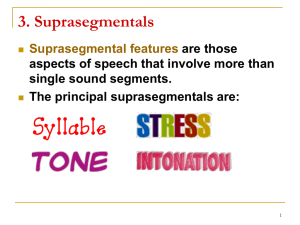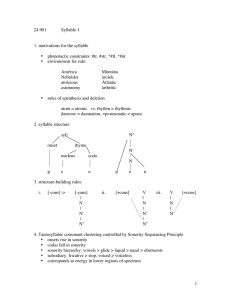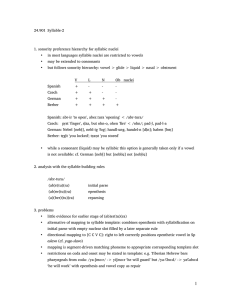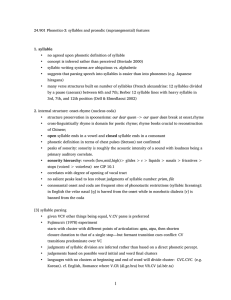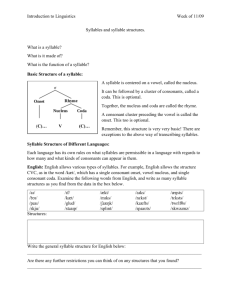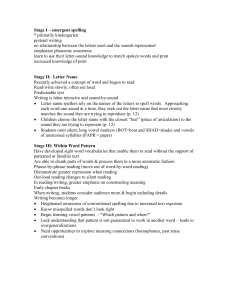24.961 Syllable-1
advertisement
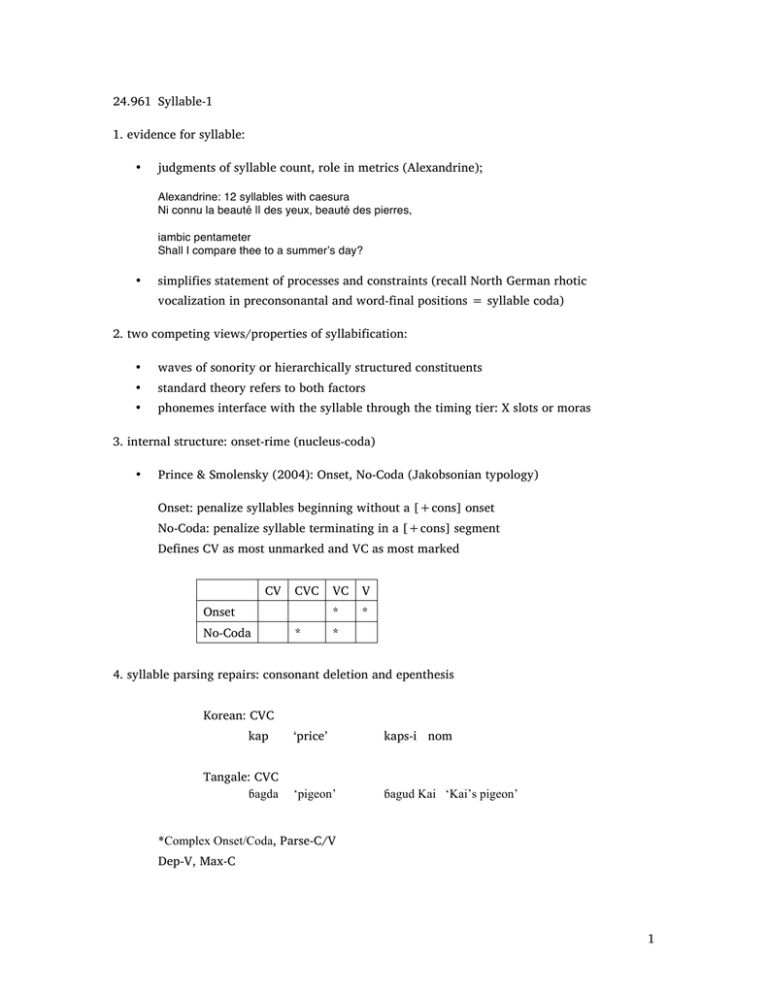
24.961 Syllable-1 1. evidence for syllable: • judgments of syllable count, role in metrics (Alexandrine); Alexandrine: 12 syllables with caesura Ni connu la beauté || des yeux, beauté des pierres, iambic pentameter Shall I compare thee to a summerʼs day? • simplifies statement of processes and constraints (recall North German rhotic vocalization in preconsonantal and word-final positions = syllable coda) 2. two competing views/properties of syllabification: • waves of sonority or hierarchically structured constituents • standard theory refers to both factors • phonemes interface with the syllable through the timing tier: X slots or moras 3. internal structure: onset-rime (nucleus-coda) • Prince & Smolensky (2004): Onset, No-Coda (Jakobsonian typology) Onset: penalize syllables beginning without a [+cons] onset No-Coda: penalize syllable terminating in a [+cons] segment Defines CV as most unmarked and VC as most marked CV CVC Onset No-Coda * VC V * * * 4. syllable parsing repairs: consonant deletion and epenthesis Korean: CVC kap Tangale: CVC ɓagda ‘price’ kaps-i nom ‘pigeon’ ɓagud Kai ‘Kai’s pigeon’ *Complex Onset/Coda, Parse-C/V Dep-V, Max-C 1 /kaps/ Parse *Complex-Coda Dep-V >kap Max-C * .kaps. *! kapis *! kap.s s! / ɓagda / Parse > ɓagud .ɓagd. *Complex-Coda Max-C Dep-V * *! *! ɓag d! ɓag.d 5. Phonotactic constraints • Recall discussion of coda/onset licensing vs. licensing by cue (class # 13) 6. sonority and nuclei • sonority peak is a syllable peak with languages setting sonority threshold on nucleus Spanish: vowel Czech: vowel, liquid German: vowel, liquid, nasal ITB: vowel, liquid, nasal, obstruent 7. Sonority Sequencing Principle (SSP) sonority rises from onset to nucleus and falls from nucleus to coda 8. Case Study: English (Clements & Keyser 1982) An.drew Max-C, Dep-V, Parse > *Complex Onset pro Max-C, Dep-V, Parse > *Complex Onset orb Max-C, Dep-V, Parse > *Complex Coda 2 Kenstowicz, Michael. Phonology in Generative Grammar. Blackwell Publishing, 1994. © Blackwell Publishing. All rights reserved. This content is excluded from our Creative Commons license. For more information, see http://ocw.mit.edu/help/faq-fair-use/. • *[ju] loses its glide after a coronal in American English • filters: avoid same place of articulation (recall Arabic OCP), perhaps motivated by syntagmatic contrast *N' / *N" \ *N" / \ lab lab / \ −sonor cor [+lateral] *N" / X \ cor +contin −anter +voiced *pw, *bw *tl, *dl N" • *t∫r, *∫l special status of [s] • s *vr, *zw w y r l m n | sp − + + + − − C st − + + − − − sk + + + + − − codas: 3-slot rime [ɛ] [e:] [ɛ] *[e:] bell bale helm [ejlm] 3 hem pep • aim elf tape hemp [ejlf] [ejmp] SSP helm elf triumph help • hemp dam<n> coronal edges: depth, apse, adze, act, fifth, apt : violate SSP wild, paint, fifths, sixths : violate length • coronal edges are an outstanding problem; suggested solutions - add coronals by a special rule - adjoin to syllable or higher constituent - leave unparsed - posit empty syllable nucleus 9. special status of sC clusters • recall sC clusters in Italian • Broselow (1983) observes that in many languages, loanwords with initial clusters are adapted with anaptyxis (epenthesis) unless they are sC, where prosthesis is preferred Farsi English (Karimi 1987) p[e]lastic d[i]rink • • f[i]loor th[i]ree [e]smoke [e]slide [e]sp[i]ring [e]ski suggests that [s] has different properties in onset vs. coda this asymmetry explored in detail in research of Suyeon Yun (2015) 10. Sonority Dispersion/Syllable Contact (Vennemann 1972) • • Penalize Coda-Onset sequences of rising sonority: i.gloo> ig.loo An.drew > And.rew Icelandic (Gouskova 2004) - initial syllable stressed; vowel is lengthened before clusters of voiceless stop or [s] followed by [r,j,v,l] : sonority rise of degree X vɪ:thja (7), vœ:kva (7), a:krar (6), thɪ:tra (6), skɔ:pra (6), tvɪ:svar (6), ɛ:sja (6) bi̥ ðja (4), stœðva (4), b̥laðra (3), visna (3), vɛlja (2), thɛvja (0), ɛvrɪ (−1), avlaɣa (−2), d̥vɛrgyr ̊ (−4) 4 analysis: - Stress-to Weight: initial stressed syllable has complex rime: long vowel or coda consonant Relational hierarchies in Optimality Theory 219 a markedness constraint against long vowels is interleaved with the sonority underlyingly short vowels will be syllabified into closed syllables as long as certain sonority between the vowels coda and following onset sonorityscale risesbanning no morea than four points.distance Underlyingly long would have- to sonority shorten, scale: as shown glidein>(19). r > l > nasal > voiced fric > voiced stop > voiceless fric > voiceless stop (19) Ban on long vowels overrides constraints against moderate sonority rise - - a. *Coda-Onset Rise evaluated from worst to best: *Coda-Onset Rise = 6 > *CodasIÔrI NoLongV *Dist\4 Ident[length] Onset Rise = 5 > *Coda-Onset Rise = 4, etc. * ™ i. sIÔ.rI so most clusters*! do not violate the contact threshold and hence will yield a ii. sI:.ÔrI b. closed sI:ÔrIstressed syllable Relational hierarchies in Optimality Theory 219 * syllabified * into closed sIÔ.rI ™ i. but when the vowels coda-onset difference is 5 orsyllables greater then theas markedness underlyingly short will sonority be as long *! than four points. Underlyingly long vowels would ii. sI:.ÔrI sonority rises no more constraint against long vowels is violated have to shorten, as shown in (19). Ban on long vowels overrides constraints against moderate sonority rise transitivity, NOLONGV dominates all of the *DIST constraints ranked (19) *a. sIÔrI NoLongV *Dist\4 Ident[length] DISTþ4 in the SCL hierarchy, so sequences with less marked de* ™ i. sIÔ.rI of sonority rise ([ðar.na] ‘ gladly ’) or with sonority fall ([hEn.!Yr] *! sI:.ÔrI ’) are ii. also heterosyllabic. When the consonant coda would create a heterosyllabic b. syllabifying sI:ÔrI rise of more than four points, * the vowel * is lengthened instead. The ™ i. sIÔ.rI contact constraints against the highest sonority rise, *DISTþ7, *DISTþ6 andii.*sI:.ÔrI DISTþ5, *! assign fatal violation marks to the heterosyllabic cluster candidates in (20), so in the vowel must and the Contact.” consonants Gouskova, Maria. “Relational Hierarchies Optimality Theory:lengthen The Case of Syllable Phonology 21, syllabified the onset: no. are 2 (2004): 201-50. into © Cambridge University Press. All rights reserved. This content is excluded from our Creative Commons license. For more information, see http://ocw.mit.edu/help/faq-fair-use/. By transitivity, NOLONGV dominates all of the *DIST constraints ranked Long are tolerated when sonority rises five points or more *Dvowels ISTþ4 in the SCL hierarchy, so sequences with less marked debelow grees sonority rise ([ðar.na] ‘ gladlyNoLongV ’) or with sonority fall ([hEn.!Yr] *Dist\5 a. of eHplI *Dist\6 ‘hands ’) are also heterosyllabic. * ™ i. e.:HplI When syllabifying the consonant coda would create a heterosyllabic *! ii. EHp.lI sonority rise of more than four points, the vowel is lengthened instead. The b. vEaHkrIr constraints against the highest sonority rise, *DISTþ7, syllable contact *DISTþ5, assign fatal violation *DISTþ6 * marks to the heterosyllabic vEa:.HkrIr ™ i.and cluster candidates in (20), so the vowel must lengthen and the consonants *! ii. vEaHk.rIr are syllabified into the onset: Gouskova, Maria. “Relational Hierarchies in Optimality Theory: The Case of Syllable Contact.” Phonology 21, one wrinkle in the pattern isPress. the syllabification of /tl/, which appearsfrom our no. 2The (2004): 201-50. © Cambridge University All rights reserved. content is excluded (20) Long vowels are tolerated when sonority rises fiveThis points or more as a heterosyllabic sequence even though its sonority rise of+5 is generally Creative Commons license. For more information, see http://ocw.mit.edu/help/faq-fair-use/. permitted Faroese. *Dist\6 *Dist\5 NoLongV a. ineHplI * e.:HplI ™ i. Tashilhiyt Case Study 2 Imdlawn Berber (Dell & Elmedlaoui 1985 et seq., 2003) *! ii. disallowed EHp.lI (21) /tl/ onsets +5 to‘pleasant’ b. consonant vEaHkrIr ITB allowsstYHt.lIjYr any be a syllabic nucleus but still optimizes the nucleus with higher sonority l¨≈Ht.lI +5 ‘little one (masc)’ * i. vEa:.HkrIr ™ if possible. Since there are long strings of consonants in the input, there are many possible parses *! ii. vEaHk.rIr that would be valid syllabifications in isolation. But speakers converge on a unique parse. Syllable parses are based on speaker judgments, versification, and grammatical rules. The one wrinkle in the pattern is the syllabification of /tl/, which appears Presents problem of global comparison and was by Prince & Smolensky (1993, 2004) to as aa heterosyllabic sequence even though itsused sonority rise of+5 is generally permitted in Faroese. motivate Optimality Theory: a small difference at one point in the string can have remote consequences--difficult to formalize with local rules that build up structure in ignorance of the final (21) /tl/ onsets disallowed stYHt.lIjYr +5 ‘pleasant’ l¨≈Ht.lI +5 ‘little one (masc)’ 5 product--but if optimization is over fully formed outputs that can be compared, then a rational attack on the problem is possible. However, there are also challenges for a completely parallel model and the ITB data have been used recently to motivate Serial OT (Pater 2012 ). 1. background • vocoids: a, i, u, y, w; high vowels and glides largely in complementary distribution1 • syllables: CV, CVC, V (initially); #CCV and VCC# clusters permitted where edge consonant is coronal; also CVCC possible if coda is geminate (ignored here) • consonant strings: in the context of voiced nuclei, transitional schwas are heard; D&E treat them as phonetic not phonological; they are analogous to the releases in the French clusters admirer, abdiquer. "ME is normally unaware of the existence of the VTV's in his speech, and …he finds it quite difficult to perceive". /t-ntl-t=tnt/ tn̩.tl̩t.tnt̩ 'you f. hid them' /kks=t t-∫∫-t=t/ k.kst.ts̩ ̩ ̩ .št ̌ ̩t 'remove it m. and eat it' /t-!bttn/ !tbt.tn ̩ ̩ 'she put a lining' 2. loans from Moroccan Arabic drop schwas; “Ashlhiy speakers are well-known for being unable to handle MA schwas (subject of comic ridicule)”. MA ITB verb noun verb noun Hbəs Həbs Hbs l-Hbs 'prison' sbət səbt sbt s-sbt 'keep the Sabbath' rzəq rəzq rzq r-rzq 'may God grant' 3. ITB syllabic nuclei span the entire gamut of the sonority scale 3sg. i- 1 2sg. t- il.di tl.di 'pull' ir.ba tr.ba 'carry on back' in.da tn.da 'shake' im.da tm.da 'be worn out' iz.di tz.di 'put together' iZ.la tZ.la 'put together' ig.za tg.za 'dig' iH.da tH.da 'give gifts' Dell & Elmedlaoui (2002) show that some glides are stable and never vocalize, requiring a lexical specification. 6 is.ti ts.ti 'select' if.si tf.si 'untie' ix.si tx.si 'go out , be extinguished' ik.ti tk.ti 'remember' Harmonic nucleus: *t, >> *s, >> *n, >> *l, >> *i,u >> *a [4] Instead of resorting to epenthesis or deletion, a simple CVC/CC,C syllable structure is obtained by allowing any consonant to form a nucleus: MAX C, DEP (V), *CCC onset/coda >> HNuc (all members of the form *Nuc(C)) /txsi/ *CCC onset HNuc (*Nuc (S)) +tx`.si √ * txsi *! √ /tsti/ MAX C HNuc (*Nuc (S)) +ts`.ti √ * sti *! √ 4. Prevocalic segments are non-syllabic: t-CCC-t t-CCC-as tr.glt trg.las 'lock' ts.krt tsk.ras 'do' tx.znt txz.nas 'store' tz.dmt tzd.mas 'gather wood' tl.bzt tlb.zas 'step onto' tr.kst trk.sas 'hide' tn.Sft tnS.fas 'graze' tm.sxt tms.xas 'transform' 7 5. Optimizing for sonorant nucleus disyllables monosyllable krm 'dry out ' gw.mr 'hunt' smd 'add' z.dm 'gather firewood' krz 'plough' r.ks 'hide' xng 'choke' n.gd 'drown' /smd/ HNuc-*t HNuc-*s > smd s.md HNuc-*n * *! * /zdm/ zdm *! > z.dm * * /ra-t-lwl-t/ -> rat.lult disyllabic /ra-t-lwl-t/ HNuc-*t /ra-t-lql-t/ -> ra.tl.qlt trisyllabic HNuc-*s HNuc-*n HNuc-*l >rat.lult HNuc-*i,u * ra.tl.wlt *!* /ra-t-lql-t/ >ra.tl.qlt rat.lq.lt ** *!* 9. Imperfective gemination perf imperf perf imperf krz kkrz rks rkks ħlb ħħlb lbʒ lbbʒ zlm zzlm ɣml ɣmml mrz mmrz rʃk rʃʃk xng xxng ʒbd ʒbbd frn ffrn xsi xssi 6. Hiatus is avoided; onsetless syllables are only found word-initially. The onset requirement can lead to a violation of Harmonic Nucleus in which a less optimal, lower sonority nucleus is chosen in order to avoid two successive syllabic nuclei. 8 /sawl-x/ -> sa.wlx /sawl-x/ Onset sa.ulx *! *HNuc-l ki.ns.ta *HNuc-i,u * >sa.wlx * /kinsta/ Onset >ki.ns̩.ta *HNuc-s *HNuc-n * ki.n̩s.ta • /kinsta/ -> *! * Dell & Elmedlaoui surmount this problem by building the onset into the first step of their algorithm, which parses a “core” CV syllable: “associate a core CV syllable with any sequence (Y)Z, where Z is /a/; where Z is a high vowel, where Z is a liquid, where Z is a nasal, …” 7. In case of a tie, a leftmost effect is found for the syllable nucleus /kywt/ *HNuc-i,u Leftmost >ki.wt * #k kyut * #ky! /rks-x/ *HNuc-s Leftmost > r.ks̩x * rk rk.sx̩ * #r, rks /tftkt/ Hnuc-stop > tf̩.tk̩t * #tft tf̩t.kt̩ * #tftk 8. No rising rimes (Clements 1997) /ugdbda/ ug.db̩.da *u.gd̩b.da avoid sonority plateau in rhyme when obstruent is nucleus /txznas/ t.xz̩ ̩ .nas “ /kšm/ k.̩ šm̩ *ks̩m ̌ /ršq/ r.̩ šk̩ *rsq̩̌ • *tx̩z.nas The latter two cases follow from the original Dell & Elmedlaoui algorithm that descends the sonority hierarchy; they challenge the parallel OT analysis based on “worst to best” H-Nuc. /ugdbda/ *Huc-stop Leftmost ug.db̩.da * ugd u.gd̩b.da * ug 9 /kšm/ *t̩ k̩.šm̩ *! *s̩ * kš̩m • *m̩ * some remedies considered include stating the constraint in positive terms going from “best to worst” or invoking a parallel set of margin (onset coda) constraints penalizing high sonority onsets and codas that can be interleaved with the peak constraint: *M/a > *M/i,u > *M/liq > *M/nas > *M/fric > *M/stop /kšm/ *M/nas *HNuc-stop > kšm̩ * kš̩m • *HNuc-fric *! * Pater (2012) argues that these data support a Harmonic Serial model of OT where just a single syllable nucleus is inserted per gen cycle first step /kšm/ *hiatus *syll.stop *syll.fric > kšm̩ *syll.nasal * kš̩m *! k̩šm *! second step / kšm̩/ *hiatus *syll.stop > k̩šm̩ *syll.fric * kšm ̩ ̩ *syll.nasal * *! * * 9. geminates: the second half of a geminate cannot be a nucleus ill.mas ‘he spun (wool) for him’ *i.ll.mas • ay.yis ‘horse’ *a.yi.ys a.faw.wu *a.fa.wuw ̩ ‘pay’ thus, a true (tautomorphemic) geminate can form coda-onset (ay.yis), nucleus coda (xlls perf), and complex coda (ill.mas), but not onset-nucleus distributing the consonant across the bisegmental sequence with the largest acoustic disparity • if the first half of a geminate is more sonorous than the second, then onset-coda parse would be a mismatch in prominence (see Morita 2014 for further examples) 10. avoid (initial) onsetless syllables /i-ukr/ yu.kr *iw.kr ‘he stole /bddl/ bd.dl ̩ *b̩d.dl ‘exchange’ /urti/ ur.ti /u-urti/ wur.ti *wr̩.ti ‘garden’ ‘garden’ construct state 10 MIT OpenCourseWare http://ocw.mit.edu 24.961 Introduction to Phonology Fall 2014 For information about citing these materials or our Terms of Use, visit: http://ocw.mit.edu/terms.
